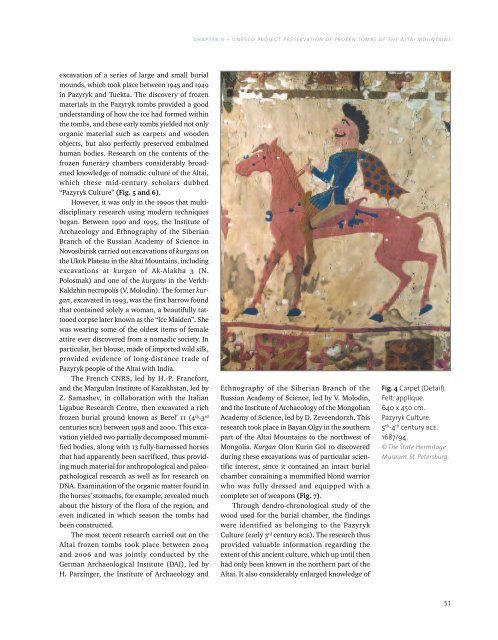Scythian Culture - Preservation of The Frozen Tombs of The Altai Mountains (UNESCO)
You also want an ePaper? Increase the reach of your titles
YUMPU automatically turns print PDFs into web optimized ePapers that Google loves.
CHAPTER II • <strong>UNESCO</strong> PROJECT PRESERVATION OF FROZEN TOMBS OF THE ALTAI MOUNTAINS<br />
excavation <strong>of</strong> a series <strong>of</strong> large and small burial<br />
mounds, which took place between 1945 and 1949<br />
in Pazyryk and Tuekta. <strong>The</strong> discovery <strong>of</strong> frozen<br />
materials in the Pazyryk tombs provided a good<br />
understanding <strong>of</strong> how the ice had formed within<br />
the tombs, and these early tombs yielded not only<br />
organic material such as carpets and wooden<br />
objects, but also perfectly preserved embalmed<br />
human bodies. Research on the contents <strong>of</strong> the<br />
frozen funerary chambers considerably broadened<br />
knowledge <strong>of</strong> nomadic culture <strong>of</strong> the <strong>Altai</strong>,<br />
which these mid-century scholars dubbed<br />
“Pazyryk <strong>Culture</strong>” (Fig. 5 and 6).<br />
However, it was only in the 1990s that multidisciplinary<br />
research using modern techniques<br />
began. Between 1990 and 1995, the Institute <strong>of</strong><br />
Archaeology and Ethnography <strong>of</strong> the Siberian<br />
Branch <strong>of</strong> the Russian Academy <strong>of</strong> Science in<br />
Novosibirisk carried out excavations <strong>of</strong> kurgans on<br />
the Ukok Plateau in the <strong>Altai</strong> <strong>Mountains</strong>, including<br />
excavations at kurgan <strong>of</strong> Ak-Alakha 3 (N.<br />
Polosmak) and one <strong>of</strong> the kurgans in the Verkh-<br />
Kaldzhin necropolis (V. Molodin). <strong>The</strong> former kurgan,<br />
excavated in 1993, was the first barrow found<br />
that contained solely a woman, a beautifully tattooed<br />
corpse later known as the “Ice Maiden”. She<br />
was wearing some <strong>of</strong> the oldest items <strong>of</strong> female<br />
attire ever discovered from a nomadic society. In<br />
particular, her blouse, made <strong>of</strong> imported wild silk,<br />
provided evidence <strong>of</strong> long-distance trade <strong>of</strong><br />
Pazyryk people <strong>of</strong> the <strong>Altai</strong> with India.<br />
<strong>The</strong> French CNRS, led by H.-P. Francfort,<br />
and the Margulan Institute <strong>of</strong> Kazakhstan, led by<br />
Z. Samashev, in collaboration with the Italian<br />
Ligabue Research Centre, then excavated a rich<br />
frozen burial ground known as Berel’ 11 (4 th -3 rd<br />
centuries bce) between 1998 and 2000. This excavation<br />
yielded two partially decomposed mummified<br />
bodies, along with 13 fully-harnessed horses<br />
that had apparently been sacrificed, thus providing<br />
much material for anthropological and paleopathological<br />
research as well as for research on<br />
DNA. Examination <strong>of</strong> the organic matter found in<br />
the horses’ stomachs, for example, revealed much<br />
about the history <strong>of</strong> the flora <strong>of</strong> the region, and<br />
even indicated in which season the tombs had<br />
been constructed.<br />
<strong>The</strong> most recent research carried out on the<br />
<strong>Altai</strong> frozen tombs took place between 2004<br />
and 2006 and was jointly conducted by the<br />
German Archaeological Institute (DAI), led by<br />
H. Parzinger, the Institute <strong>of</strong> Archaeology and<br />
Ethnography <strong>of</strong> the Siberian Branch <strong>of</strong> the<br />
Russian Academy <strong>of</strong> Science, led by V. Molodin,<br />
and the Institute <strong>of</strong> Archaeology <strong>of</strong> the Mongolian<br />
Academy <strong>of</strong> Science, led by D. Zeveendorzh. This<br />
research took place in Bayan Olgy in the southern<br />
part <strong>of</strong> the <strong>Altai</strong> <strong>Mountains</strong> to the northwest <strong>of</strong><br />
Mongolia. Kurgan Olon Kurin Gol 10 discovered<br />
during these excavations was <strong>of</strong> particular scientific<br />
interest, since it contained an intact burial<br />
chamber containing a mummified blond warrior<br />
who was fully dressed and equipped with a<br />
complete set <strong>of</strong> weapons (Fig. 7).<br />
Through dendro-chronological study <strong>of</strong> the<br />
wood used for the burial chamber, the findings<br />
were identified as belonging to the Pazyryk<br />
<strong>Culture</strong> (early 3 rd century bce). <strong>The</strong> research thus<br />
provided valuable information regarding the<br />
extent <strong>of</strong> this ancient culture, which up until then<br />
had only been known in the northern part <strong>of</strong> the<br />
<strong>Altai</strong>. It also considerably enlarged knowledge <strong>of</strong><br />
Fig. 4 Carpet (Detail).<br />
Felt; applique.<br />
640 x 450 cm.<br />
Pazyryk <strong>Culture</strong>.<br />
5 th -4 th century bce.<br />
1687/94.<br />
© <strong>The</strong> State Hermitage<br />
Museum, St. Petersburg.<br />
51
















